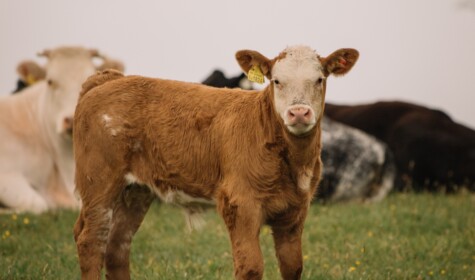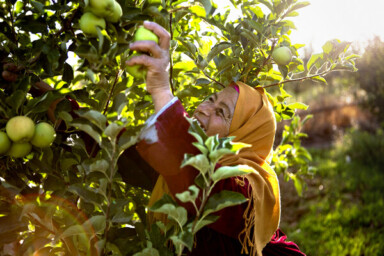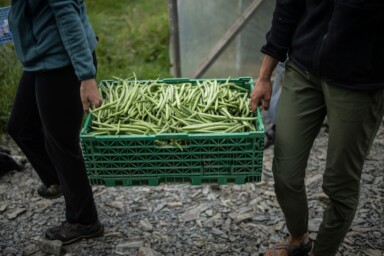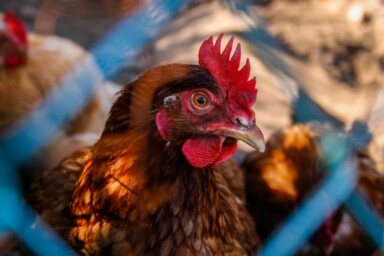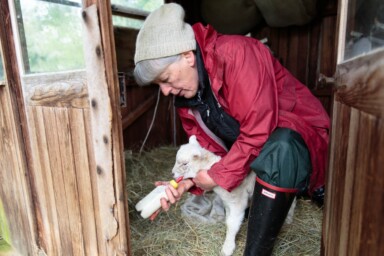The variety of cattle breeds is glorious. Whitebred Shorthorns have pure white coats and pink noses. Dark noses and ears give British White particularly expressive faces. White Parks, with their long, wide horns, wouldn’t look out of place in Texas. In the Alps, there are Evolèner with brown coats and a white triangle marking on their faces or Rätisches Grauvieh, all grey with white trimmings along the ears.
For images of beautiful, cute or distinguished looking and, overall, amazing cows, scroll through the pages of the Rare Breed Survival Trust, or, for similarly remarkable impressions from the continent, go to Pro Specie Rara. But as gorgeous as the animals may be, does it matter whether anyone keeps these breeds alive? It does, because each of them expresses genetic traits that we will likely need in the future, as the climate crisis accelerates and high-performance breeds no longer perform.
No cow will ever produce as much milk as a Holstein, and few cattle will put on meat faster than Black Angus. For decades breeders have successfully selected animals for milk yield or meat. In 1996, a dairy cow in the UK produced on average 5800 litres of milk annually; in 2018 it was almost 8000 litres. Dairy and meat cattle have become high performance athletes.
For farmers, artificial insemination is a great tool to select cattle for productivity. Instead of keeping a bull, they can go online and look through the database of breeders and genetics companies that list profiles of breeding bulls in the UK and the rest of the world. Detailed information is available on the traits each bull is likely to pass on, such as the milk yield of the daughters they sired, body type or ease of calving. Once ordered, the semen will arrive within two to four working days. Of course, semen from high performance breeding bulls is in particular demand and some of them will have sired tens of thousands of offspring.
In an article for Scientific American, Maureen O’Hagan reported last year, that Pennsylvania State University had looked at the genetics of male lines in Holstein cattle. They found that 99% of the roughly 9 million Holstein dairy cows in the US could be traced back to two bulls which were born in the 1960s. ‘What we’ve done is really narrowed down the genetic pool,’ says Chad Dechow, one of the researchers. O’Hagan comments that, ‘Any elementary science student knows that genetic homogeneity isn’t good in the long term. It increases the risk of inherited disorders while also reducing the ability of a population to evolve in the face of a changing environment.’ O’Hagan concludes: ‘There will be no more improvement in milk production. Fertility won’t improve. And if a new disease comes along, huge swaths of the cow population could be susceptible, since so many of them have the same genes.’
The only way forward will be to enlarge the genetic pool through crossbreeding. And that’s where rare breeds come in: each of these breeds possesses a large number of traits that have long been bred out of the high-performance animals. And most rare breeds are regionally adapted. They thrive in a particular landscape and climate, and eat the particular forage available there.
I learned from Del Ficke how breeders can use this to their advantage when I visited him on his farm near Lincoln in south eastern Nebraska. Ficke’s great-grandfather, John Ficke, emigrated to the US from Germany in 1860, and in 1869, he founded what today is the Ficke Cattle Company. Some 70 years ago, the family started breeding Hereford beef cattle. As the name implies, Herefords originally came from Herefordshire in the UK. ‘It’s the cow that won the West,’ says Ficke. Today, the most common beef cattle breed in the US is Black Angus. It derived from Aberdeen Angus, a small, robust breed. But Black Angus have little in common with their frugal Scottish ancestors: most of them have forgotten how to graze because they are so used to their daily corn silage ration.
‘Cattle are all geared towards feedlot production’, says Del Ficke, ‘in 50 years we bred all the good out of cattle. It is all about efficiency, how to get the cattle to put on the most weight in the shortest period of time.’ To him there is little value in breed associations and pure lines. The animals are bred for a certain look that distinguishes them from other breeds and one criterion only: feed efficiency. ‘When it works, it is called line breeding; if it doesn’t work, it is called inbreeding,’ says Ficke. Dairy cattle were selected for milk yield and often have thinner, bonier frames. Beef cattle breeds went the opposite way – today most look like the bovine equivalent of a prize fighter. How big an animal grows and how efficiently it uses food to put on meat is genetically determined. The better the relevant genes are expressed, the more valuable they get. Ficke gives the example of Aberdeen Angus. ‘Angus went from being small animals in the 1960s to being giants. They have the capacity to take in huge amounts of feed in a very short time,’ which means they put on a lot of weight, fast. But ‘modern’ Angus cannot exist without people feeding them, without drugs and without the care of a vet. ‘They really stand on good grassland and don’t graze because they are waiting for the feed truck to pull up’, says Del Ficke.
And that is a ridiculous situation because cattle co-evolved with grasslands. They are ruminants and with their four stomachs and the help of gazillions of gut bacteria, they are able to transform grass into calories. Their digestive systems are not set up to feed on maize, in the same way our stomachs cannot digest grass. It took decades of breeding to get cows to cope with a high calorie maize and grain diet – feed the animals need to produce extraordinary milk yields or put on weight in record time. To farmers and ranchers such as Del Ficke, grazing cattle are an integral part of a functioning agricultural system that is based on healthy soil rather than on chemical fertilisers and pesticides.
Del Ficke started crossbreeding in 1984. His aim was to breed cattle that was resilient and up to the job of grazing. ‘I want the most accountable cow herd. They need to do what I want them to do and I want the best soil’, says Ficke. Over the years he has brought genetics from a variety of different breeds into the herd, each chosen for the particular traits they bring. He started out with Herefords as ‘they reliably produce a calf every year’. He crossed them with Red Angus who are very maternal, unlike Black Angus who can be difficult to handle. Next came Simmentals, popular in southern Germany and Switzerland because they are a ‘dual use’ breed which can be raised for milk or beef. Ficke likes them because they use water more efficiently. ‘They drink about half of what others consume which is important in an area where you need to conserve moisture’. French Aubrac contribute other important traits: they forage efficiently and are known for very tender, aromatic meat.
By 2014, Ficke had a cattle herd with the right genetics: the animals can stay on grassland year-round and do not need to be housed in winter, a season that can be very harsh in the Midwest. They make do with whatever pasture they are being offered, their thick coats keep them warm and the cows are good mothers. They have a smaller frame than other breeds, which means they calve with ease and almost never need assistance. And when their meat ends up as a Sunday roast or steak, the quality is such that it’s sought after by chefs, says Ficke who sells a few of his animals for meat every year.
The family tree of his cattle includes roughly 20 different breeds and what he calls ‘cowboy genetics’, Ficke tells me as we are driving to see the cows. They are grazing on a hill top from where we have a great view across the beautiful, rolling Nebraska landscape and the farmhouse. We make heads turn as we walk across the pasture, but after a short inspection the animals return to grazing or chewing their cud. All have a thick reddish-brown coat, some lighter, some darker, and many sport white markings on their faces.
Ficke took a conscious decision to register his cattle as ‘GrazeMaster’ brand and not as a breed, he wants the genetics to remain diverse. The animals should be well suited, happy and thriving in different regions, on different forage and in varying climates. When he sells a bull or a heifer, he helps farmers to choose animals with genetics that make them ideally suited to their particular ranch or farm. Semen is available, too.
Over time, the GrazeMasters will continue to change, and rare breeds will continue to hold the genetic potential we may need in the future.
